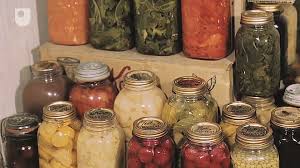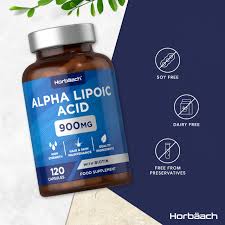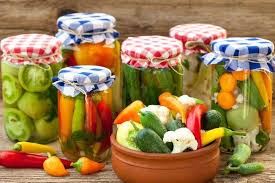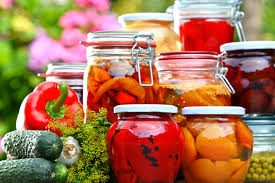Preservatives are used to improve the colour and keeping qualities of the final product for some fruits and vegetables. Preservatives include items such as sulphur dioxide, ascorbic acid, citric acid, salt, and sugar and can either be simple or compound solutions.
The concept of combinations of preservatives and treatments to preserve foods is frequently called the hurdle or barrier concept.
Combinations of additives and preservatives systems provide unlimited preservation alternatives for applications in food products to meet consumer demands for healthy and safe foods.
Read Also: Challenges and Potential of Snail Farming
Application of Preservatives During Processing

Treatment with preservatives takes place after blanching or, when blanching is not needed, after slicing. In traditional, simple processing the method recommended is:
put enough preservative solution to cover the cloth bag into a container/pan;
dip the bag containing the product into the preservative solution for the amount of time specified, remove the bag and put it on a clean tray while the liquid drains out.
The liquid which drains out must not go back into the preservative solution because it would weaken the solution.
Care must be taken after each dip to refill the container to the original level with fresh preservative solution of correct strength.
After five lots of material have been dipped, the remaining solution is thrown away; i.e. a fresh lot of preservative solution is needed for every 5 lots of material.
The composition and strength of the preservative solution vary for different fruit and vegetables. The strength of sulphur dioxide is expressed as “parts per million” (ppm).
1.5 grams of sodium meta-bisulphite in one litre of water gives 1000 ppm of sulphur dioxide.
Sodium bicarbonate is added to the blanching water when okra, green peas and some other green vegetables are blanched. The chemical raises the pH of the blanching water and prevents the fresh green colour of chlorophyll being changed into pheophytin which is unattractive brownish-green.
The preservative solutions in the fruit and vegetable pre-treatment can only be used in enameled, plastic or stainless-steel containers; never use ordinary metal because solutions will corrode this type of container.
As a general rule, preservatives are not used for treating onions, garlic, leeks, chilies and herbs.
Chemical Preservation of Agricultural Produce
Many chemicals will kill micro-organisms or stop their growth but most of these are not permitted in foods.
Chemical food preservatives are those substances which are added in very low quantities (up to 0.2%) and which do not alter the organoleptic and physico-chemical properties of the foods at or only very little.
Preservation of food products containing chemical food preservatives is usually based on the combined or synergistic activity of several additives, intrinsic product parameters (e.g. composition, acidity, water activity) and extrinsic factors (e.g. processing temperature, storage atmosphere and temperature).
This approach minimizes undesirable changes in product properties and reduces concentration of additives and extent of processing treatments.
The concept of combination of preservatives and treatments to preserve foods is frequently called the hurdle or barrier concept.
Combination of additives and preservatives provide unlimited preservation alternatives for applications in food products to meet consumer demands for healthy and safe foods.
Chemical food preservatives are applied to foods as direct additives during processing, or develop by themselves during processes such as fermentation.
Certain preservatives have been used either accidentally or intentionally for centuries, and include sodium chloride (common salt), sugar, acids, alcohols and components of smoke.
In addition to preservation, these compounds contribute to the quality and identity of the products, and are applied through processing procedures such as salting, curing, fermentation and smoking.
Traditional Chemical Preservatives in Food Processing
Traditional chemical food preservatives and their use in fruit and vegetable processing technologies could be summarised as follows:
1. Common salt: brined vegetables;
2. Sugars (sucrose, glucose, fructose and syrups): foods preserved by high sugar concentrations such as jellies, preserves, syrups, juice concentrates; interaction of sugar with other ingredients or processes such as drying and heating; indirect food preservation by sugar in products where fermentation is important (naturally acidified pickles and sauerkraut).
Acidulants and other preservatives formed in or added to fruit and vegetable products are as follows:
1. Lactic acid: the main product of many food fermentations; it is formed by microbial degradation of sugars in products such as sauerkraut and pickles.
The acid produced in such fermentations decreases the pH to levels unfavourable for growth of spoilage organisms such as putrefactive anaerobes and butyric-acid-producing bacteria.
Yeasts and molds that can grow at such pH levels can be controlled by the inclusion of other preservatives such as sorbate and benzoate.
2. Acetic acid: a general preservative inhibiting many species of bacteria, yeasts and to a lesser extent molds. It is also a product of the lactic-acid fermentation, and its preservative action even at identical pH levels is greater than that of lactic acid.
The main applications of vinegar (acetic acid) include products such as pickles, sauces and ketchup.
Other Commonly Used Acidulants in Food Preservation
1. Malic and tartaric (tartric) acids: used in some countries mainly to acidify and preserve fruit sugar preserves, jams, jellies, etc.
2. Citric acid: the main acid found naturally in citrus fruits; widely used (in carbonated beverages) and as an acidifying agent of foods because of its unique flavour properties.
It has an unlimited acceptable daily intake and is highly soluble in water. It is a less effective antimicrobial agent than other acids.
3. Ascorbic acid or vitamin C: its isomer isoascorbic or erythorbic acid and their salts are highly soluble in water and safe to use in foods.
Lipophilic Acid Preservatives Used in Food Processing

1. Benzoic acid: in the form of its sodium salt, constitutes one of the most common chemical food preservatives. Sodium benzoate is a common preservative in acid or acidified foods such as fruit juices, syrups, jams and jellies, sauerkraut, pickles, preserves, fruit cocktails, etc. Yeasts are inhibited by benzoate to a greater extent than are moulds and bacteria.
2. Sorbic acid: generally considered non-toxic and is metabolised; among other common food preservatives the WHO has set the highest acceptable daily intake (25 mg/kg body weight) for sorbic acid.
Sorbic acid and its salts are practically tasteless and odourless in foods, when used at reasonable levels (< 0.3%) and their antimicrobial activity is generally adequate.
Sorbates are used for mould and yeast inhibition in a variety of foods including fruits and vegetables, fruit juices, pickles, sauerkraut, syrups, jellies, jams, preserves, high moisture dehydrated fruits, etc.
Potassium sorbate, a white, fluffy powder, is very soluble in water (over 50%) and when added to acid foods it is hydrolysed to the acid form.
Sodium and calcium sorbates also have preservative activities but their application is limited compared to that for the potassium salt, which is employed because of its stability, general ease of preparation and water solubility.
Gaseous Preservatives Used in Food Storage and Processing
1. Sulphur dioxide and sulphites: Sulphur dioxide (SO2) has been used for many centuries as a fumigant and especially as a wine preservative. It is a colourless, suffocating, pungent-smelling, non-flammable gas and is very soluble in cold water (85 g in 100 ml at 25°C).
Sulphur dioxide and its various sulphites dissolve in water, and at low pH levels yield sulphuric acid, bisulphite and sulphite ions. The various sulphite salts contain 50-68% active sulphur dioxide.
A pH dependent equilibrium is formed in water and the proportion of SO2 ions increases with decreasing pH values. At pH values less than 4.0 the antimicrobial activity reaches its maximum.
Sulphur dioxide is used as a gas or in the form of its sulphite, bisulphite and metabisulphite salts which are powders. The gaseous form is produced either by burning sulphur or by its release from the compressed liquefied form.
Metabisulphites are more stable to oxidation than bisulphites, which in turn show greater stability than sulphites.
The antimicrobial action of sulphur dioxide against yeasts, moulds and bacteria is selective, with some species being more resistant than others. Sulphur dioxide and sulphites are used in the preservation of a variety of food products.
In addition to wines these include dehydrated/dried fruits and vegetables, fruit juices, acid pickles, syrups, semi-processed fruit products, etc.
In addition to its antimicrobial effects, sulphur dioxide is added to foods for its antioxidant and reducing properties, and to prevent enzymatic and non-enzymatic browning reactions.
2. Carbon dioxide (CO2): a colourless, odourless, non-combustible gas, acidic in odour and flavour. In commercial practice it is sold as a liquid under pressure (58 kg per cm³) or solidified as dry ice. Carbon dioxide is used as a solid (dry ice) in many countries.
General Rules for Chemical Preservation
Chemical preservatives must be applied only at levels necessary to achieve normal preservation effects.
Excessive usage is discouraged, as it may pose health risks and reduce food quality. Reapplication or “reconditioning” of chemical preservatives is not recommended, especially if microbial spoilage has already occurred.
Only substances recognized as safe and approved by national and international standards should be used in food preservation.
Read Also: The Complete Guide to Snail Farming Techniques
Factors Influencing the Action of Chemical Food Preservatives

A. Factors Related to Chemical Preservatives
1. Chemical composition – Determines the type and range of micro-organisms the preservative can inhibit.
2. Concentration – Higher concentration may enhance effectiveness but must stay within permissible limits to ensure safety.
B. Factors Related to Micro-Organisms
1. Species of micro-organisms – Different preservatives work against specific groups:
i. Sulphur dioxide is broadly effective against bacteria, yeasts, and moulds.
ii. Benzoic acid is more potent against bacteria than fungi.
iii. Sorbic acid targets moulds and certain yeasts; at higher levels, it can affect bacteria, excluding lactic and acetic species.
iv. Formic acid is more active against yeasts and moulds.
2. Initial microbial load – The fewer micro-organisms present at the start, the more efficient the preservative.
A high microbial load due to poor hygiene or early spoilage weakens the preservative’s effect.
C. Factors Related to the Product
1. Chemical composition – Can affect preservative compatibility and distribution.
2. pH level – Most chemical preservatives work best in acidic environments (low pH).
3. Physical state and size – Finely sliced products absorb preservatives better. Viscous products hinder even dispersion, reducing effectiveness.
D. Miscellaneous Factors
1. Temperature – Influences preservative dosage and microbial resistance.
2. Time – Some preservatives, such as benzoic acid, may require weeks to be fully effective; others, like sulphurous acid, act more quickly.
Common Chemical Food Preservatives
| Preservative | Acceptable Daily Intake (mg/kg bw) | Typical Usage Level (%) |
|---|---|---|
| Lactic acid | No limit | No limit |
| Citric acid | No limit | No limit |
| Acetic acid | No limit | No limit |
| Sodium diacetate | 15 | 0.3 – 0.5 |
| Sodium benzoate | 5 | 0.03 – 0.2 |
| Sodium propionate | 10 | 0.1 – 0.3 |
| Potassium sorbate | 25 | 0.05 – 0.2 |
| Methyl paraben | 10 | 0.05 – 0.1 |
| Sodium nitrite | 0.2 | 0.01 – 0.02 |
| Sulphur dioxide | 0.7 | 0.005 – 0.2 |
Common Applications
1. Citric acid: Fruit juices, jams, sugar preserves.
2. Acetic acid: Pickled vegetables, sauces.
3. Sodium benzoate: Jams, jellies, pickles.
4. Sodium propionate: Preserved fruits and vegetables.
5. Potassium sorbate: Jams, pickles, fruit products.
6. Methyl paraben: Pickles, fruit-based foods.
7. Sulphur dioxide: Juices, dried/dehydrated fruits and vegetables.
Preservation of Vegetables by Acidification
A. Natural Acidification (Biochemical Preservation)
Natural acidification is based on lactic fermentation, where lactic acid bacteria outcompete harmful microbes under low-oxygen, saline conditions. An example is fermented cucumbers:
- Cucumbers are immersed in brine without heating.
- Salt and oxygen deficiency kill cucumber cells.
- Cell contents seep into the brine, feeding lactic bacteria.
- A pH of 4.1 or below is typically reached within 3 days, ensuring safety.
B. Artificial Acidification
This involves adding acetic acid, a safe organic acid. The method relies on the acidoanabiosys principle (inhibiting microbial activity through acid conditions). Sometimes, combined acidification is practiced by first fermenting and then adding vinegar.
Examples:
Sauerkraut and pickles are preserved either by heating and sealing or by adding safe preservatives under FDA regulations.
Preservation with Sugar
Preservation with sugar is based on increasing osmotic pressure to inhibit microbial growth. Normally, boiling reduces water content, allowing sugar concentration to reach the required 60% for preservation.
Heat Preservation / Heat Processing
1. Sterilisation
This involves complete destruction of all micro-organisms, including spores. Achieved by heating food to 121°C for at least 15 minutes. The heat must fully penetrate the product for effectiveness.
2. Commercial Sterility
This level is sufficient for most canned or bottled foods, offering a shelf life of up to two years under proper storage.
3. Pasteurization
A milder heat treatment, typically below 100°C, intended to:
i. Extend shelf life.
ii. Reduce microbial and enzymatic activity.
iii. Often combined with other methods (e.g., acidification, sugar).
4. Blanching
A quick heat treatment used mainly for vegetables to:
i. Inactivate enzymes.
ii. Destroy some microbes.
iii. Usually done before freezing or drying.
Food Irradiation
Food irradiation is a non-thermal preservation method that:
i. Kills or inactivates micro-organisms responsible for spoilage and food-borne illnesses.
ii. Increases shelf life without significant temperature rise.
iii. Requires controlled application and regulatory approval to ensure food safety and quality.
Do you have any questions, suggestions, or contributions? If so, please feel free to use the comment box below to share your thoughts. We also encourage you to kindly share this information with others who might benefit from it. Since we can’t reach everyone at once, we truly appreciate your help in spreading the word. Thank you so much for your support and for sharing!

